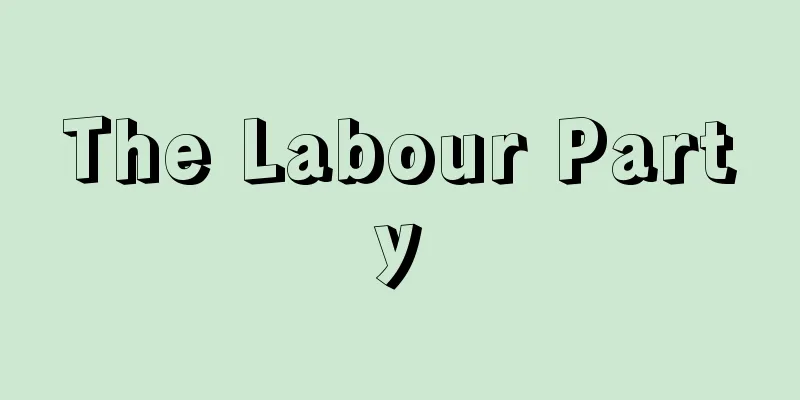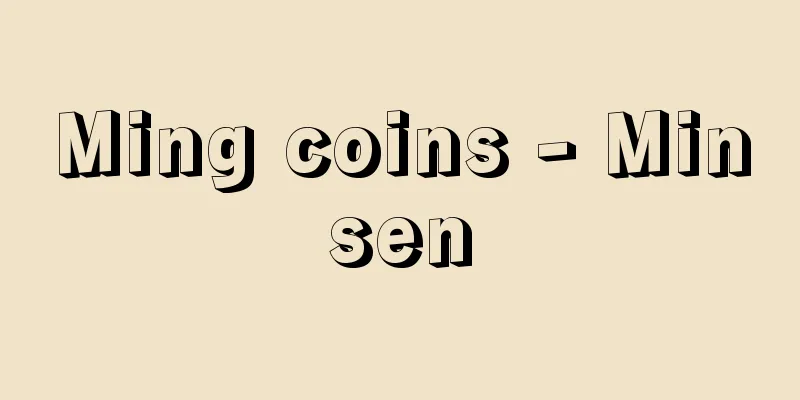The Labour Party

|
A political party in the UK. It is one of the two major parties alongside the Conservative Party, and has a long history of governing. Among the parties based on the working class, it has espoused reformist socialism, mainly based on the ideas of the Fabian Society, in contrast to parties that follow Marxism, but at the end of the 20th century it moved away from socialism and became the "New Labour Party", which is less of a party representing trade unions. [Kazuo Inudo] Establishment of the PartyThe British Trade Union Congress (TUC) responded to the appeals of the Independent Labour Party (founded in 1893) created by Keir Hardie, and in 1900, at a conference held in London by trade unions, the Independent Labour Party, the Fabian Society, and others, the Labour Representation Committee was formed to represent labour interests in Parliament. This was the predecessor of the Labour Party, which was renamed the Labour Party in 1906. However, until World War I, it acted as a party of trade union interests, and had poor constituency organization. [Kazuo Inudo] Interwar periodThe outbreak of World War I gave rise to a conflict between those in favor of non-war and those in favor of participation in the war, and Ramsay MacDonald, a former member of the Independent Labour Party, handed over his position as leader to Arthur Henderson, a member of the latter party, in 1914. The mainstream supporters of participation in the war, including Henderson, were included in the coalition government. In 1917-1918, towards the end of the First World War, the Labour Party reformed by formulating new party rules, reorganized by allowing individual membership to constituency parties, and created a platform called "Labour and the New Social Order" with the goal of socialism through the nationalization of the means of production. The party's influence grew rapidly after that, and in the 1923 general election, it became the second largest party by a large margin, with 191 members elected, far surpassing the Liberal Party, and under MacDonald (who returned to the leadership in 1922), it formed a minority government, albeit a short-lived one. In the 1929 general election, it became the largest party, with 287 members elected, surpassing the Conservative Party, and formed the Second MacDonald Cabinet, but it struggled with the Great Depression and collapsed in the midst of the financial panic in August 1931 without any solution, and Prime Minister MacDonald formed a national unity cabinet with the Conservative and Liberal parties. The Labour Party expelled MacDonald and elected former Foreign Secretary Henderson as leader, becoming the opposition party, but in the general election in October of the same year, it fell to 46 seats. As the party leader and other former cabinet members lost their seats, the pacifist George Lansbury (1859-1940) became leader, and in October 1935, Clement Attlee was elected leader. In the general election that same year, the party recovered to 154 seats, but in the late 1930s, serious internal divisions arose over the Popular Front movement. However, during World War II, the party was instrumental in establishing Churchill's wartime coalition government, and Attlee, Ernest Bevin, Herbert Morrison and others joined the cabinet and held important posts in domestic politics. [Kazuo Inudo] After World War IIIn the 1945 general election after the end of the war with Germany, the Labour Party won 394 seats out of 640, and organized a one-party cabinet under Attlee. It nationalized key industries and implemented drastic reforms to the social security system, establishing a mixed economy and welfare state. Externally, the Labour Party supported NATO during the Cold War and pursued a policy of rearmament, but the left wing, represented by Aneurin Bevan, opposed this, which led to serious internal conflict within the party, and the party lost power to the Conservative Party in the 1951 general election. In 1955, Hugh Gaitskell was chosen as Attlee's successor, but due to internal left-right conflict, the party suffered consecutive defeats in the 1955 and 1959 general elections, and after Gaitskell's death, Harold Wilson was chosen as party leader in 1963. In the following general election in 1964, the Labour Party won 317 seats out of 630, and in the 1966 general election, it won 364 seats. However, the policy of economic reconstruction through modernization of the industrial structure was not effective, and the negotiations for joining the EC (European Community) did not bear fruit, and the Labour Party lost to the Conservative Party in the 1970 general election and became the opposition party. In the February 1974 general election, the Labour Party returned to power under Wilson with 301 seats out of 635, and in the general election in October of the same year, the Labour Party barely won a majority, but was able to maintain power thanks to the social contract with the Trades Union Congress (an agreement in which the government secured real wages and asked the trade unions to independently suppress wages). The position of Prime Minister and party leader was taken over by James Callaghan in 1975, and crisis management was centered on income policy, but in 1978, dissatisfaction among the trade unions grew, the social contract was broken as the labour movement entered a period of winter, and the party was defeated by the Conservative Party in the following general election in 1979. In 1980, the party leader was replaced by Michael Mackintosh Foot (1913-2010). In the 1974 general election, Labour's share of the vote fell below 40%, then to 37% in 1979, and to 27.6% in 1983 due to a shift to the left and party disunity, leading to Neil Gordon Kinnock (1942- ) becoming leader in an attempt to get the party back on track. In 1981, a wing of the right wing, opposed to the shift to the left, left the party to found the Social Democratic Party, which formed an alliance with the Liberal Party, and although Labour recovered to 32% in the 1987 general election, it suffered three consecutive defeats. In the wake of this shock, the Labour Party embarked on a radical reform under the Shadow Cabinet led by Kinnock, and in 1990, the party rebuilt its strength by adopting a policy of accepting the privatisation of nationalised industries and labour legislation under the Thatcher government, and took part in the 1992 general election. The party won 42 more seats than in the previous election, and received 34.4% of the vote, but was unable to gain power, so Kinnock resigned as leader and John Smith (1938-1994), a former cabinet minister, became leader. Under Smith, reforms were also made to modernise the party, and in the vote at the party conference, trade unions' bloc vote share, which had previously amounted to 90% of the vote, was reduced to 70%, making it clear that the party was moving towards realising the principle of one person, one vote. [Kazuo Inudo] New Labour PartyAfter Smith's sudden death in the spring of 1994, Tony Blair, who had been the Home Secretary in the Shadow Cabinet, became the leader of the party at the young age of 41. Under Blair's Shadow Cabinet led by reformers (modernizers), the Labour Party became a party called New Labour. This was supported by the removal of the public ownership principle, which was stated in Article 4 of the party constitution, from the party's objectives at the party conference in April 1995. The principle of public ownership in Article 4 of the constitution was established in 1918 and was drafted by Fabianist Sidney J. Webb (1859-1947). Blair removed this principle from the party's objectives and changed it to the creation of a society based on solidarity and observance of obligations among citizens, and a society in which individuals can realize their potential. Through these reforms, mainly the amendment of the party rules, the Labour Party became a modernized New Labour, and the party organization was run mainly by individual party members who had joined from the trade unions. As a result of these reforms, the number of individual party members increased from 280,000 to 420,000 between the time Blair became party leader and the 1997 general election. In the general election in May of that year, the party led by Blair increased its vote share to 43.2%, significantly higher than the previous election, and won a landslide victory with 418 seats, which can be said to be the result of the New Labour reforms. In this election, preferential treatment was given to female candidates, especially in constituencies where they had a high chance of winning, and 155 candidates, the highest number in history, were nominated, resulting in 101 female members of the House of Representatives, exceeding the 37 in the previous election. This phenomenon clearly showed the changes in the Labour Party as it became New Labour. A feature of the administration since the formation of the Blair Cabinet is that in domestic affairs, it has placed emphasis on political reform to change the country's political structure. Parliaments were established in Scotland, Wales, and Northern Ireland in 1999, and the country changed from a centralized system to a decentralized system. The UK's electoral system, which had previously adopted a single-seat constituency system, was changed to a proportional representation system, and the traditional single-seat constituency system was no longer used for European Parliament elections and local assembly elections in Scotland, Wales, and Northern Ireland from 1999. The Blair Cabinet ran a stable government and won a landslide victory in the 2001 general election, but during its second term it received strong public criticism for its response to the 2003 Iraq War, and in the 2005 general election, although it won a majority, it lost a large number of seats. The Blair Cabinet was the first Labour Party to hold power for three consecutive terms, but its approval ratings were low and it also suffered a major defeat in the 2006 local council elections. Calls for his early resignation from opponents within the party gradually grew stronger, and Blair announced his resignation in May 2007. At an extraordinary party conference on June 24, Chancellor of the Exchequer Gordon Brown was elected as his successor as party leader, and Blair resigned on June 27 of the same year with three years left in his term, with Brown becoming Prime Minister. [Kazuo Inudo] OrganizationThe Labour Party consists of the National Organisation and the Parliamentary Labour Party (PLP). The National Party consists of the Constituency Party, which is mainly made up of individual members (200,000 in 1993, 420,000 in 1997), and the affiliated trade unions, which have a large number of members who pay dues. In 1992, there were 25 unions with block votes of more than 20,000 at the National Conference, and in 1993, 4 million of the 8 million members of the affiliated trade unions were dues payers. The Trade Unions Act of 1984 required the consent of the members to collect dues from union members. The annual party conference is the highest decision-making body of the party. The National Executive Committee (NEC), which oversees the National Organisation, elects 29 members at the conference every year, including the leader, deputy leader and treasurer of the Parliamentary Labour Party, 7 members from the Constituency Party, 12 members from the affiliated trade unions, 5 women and 2 others. Most of the PLP's executive, the parliamentary committees, and the shadow cabinet in the opposition, are elected by a vote of members of the House of Commons before Parliament opens after a general election. The leader and deputy leader were traditionally elected among PLP members, but in 1981 they were elected by the entire party, with the ratio of 30 PLP, 30 constituency parties, and 40 trade unions. In these leadership elections, Kinnock was elected in 1983, Smith in 1992, and Blair in 1994. John Leslie Prescott (1938- ) was chosen as Blair's deputy leader, and later became Deputy Prime Minister and First Minister of State. In 2007, following Blair's announcement of his retirement, there was no leadership election, as Gordon Brown was the only candidate. The Deputy Leader was Harriet Harman (1950-), the Minister for Justice, who was also appointed Secretary of State for Labour and Leader of the House of Commons. As of 1996, individual membership dues are £15 per year. Students, part-time workers and retired people pay £5, and dues-paying members of trade unions pay £3. [Kazuo Inudo] "A History of the British Labour Party" by Yoshihiko Seki (1969, Shakai Shisosha)" ▽ "A History of the British Labour Party" by H. Pelling, translated by Kiichi Ogawa (1967, Nippon Hyoronsha)" ▽ "British Political Parties - Power Distribution within the Conservative and Labour Parties, Volume 2" by R.T. Mackenzie, translated by Takashi Hayakawa and Junsei Misawa (1970, Yuhikaku)" ▽ "The British Labour Party" by Ichiro Murakawa (1978, Kyoikusha) ▽ "The British Labour Party - Beyond Social Democracy" by Seisuke Yoshise (1997, Madosha) ▽ "Blair's Britain - Welfare New Deal and New Industrialism" by Masatomi Funaba (1998, PHS Research Institute) ▽ "This is the British Labour Party" by Shingo Hayashi (1999, Shincho Sensho)" ▽ Sugimoto Minoru, A Study of the History of the British Labour Party: The Formation and Development of the Labour Alliance (1999, Hokuju Shuppan, Gakubunsha) Richard Heffernan, translated by Mochizuki Shogo, Political Changes in Modern Britain: The New Labour Party and Thatcherism (2005, Tokai University Press) E. Shaw, The Labour Party Since 1945 (1996, Blackwell Publishers) S. Driver, L. Martell, New Labour; Politics After Thatcherism (1998, Polity Press) HJP Harmer, The Longman Companion to the Labour Party, 1900-1998 (1999, Longman) Gerald R. Taylor (ed.), The Impact of New Labour (1999, St Martins Press) [References] | | | | | | | | | | | | | | | | | | | |Source: Shogakukan Encyclopedia Nipponica About Encyclopedia Nipponica Information | Legend |
|
イギリスの政党。保守党と並ぶ二大政党の一つであり、政権担当歴も豊か。労働者階級を基盤とする政党のなかでも、マルクス主義の流れをくむ党とは対照的な、おもにフェビアン協会の思想による改革主義の社会主義を信奉してきたが、20世紀末からはその社会主義から離れ、労働組合の代表という政党色を薄めた「新しい労働党」(New Labour)となった。 [犬童一男] 党の成立ケア・ハーディがつくった独立労働党(1893年結成)の働きかけにイギリス労働組合会議(TUC)が応じ、1900年にロンドンで労組と独立労働党、フェビアン協会などによる大会で、議会における労働利益代表たる労働代表委員会が結成された。これが労働党の前身であるが、1906年に労働党と改称。しかし第一次世界大戦までは労組利益党として行動し、選挙区組織も貧弱であった。 [犬童一男] 両大戦間期第一次世界大戦の勃発(ぼっぱつ)で非戦論と参戦論との対立が生まれ、前者の独立労働党出身のラムゼー・マクドナルドは、1914年、党首の地位を後者のアーサー・ヘンダーソンに譲った。参戦論の主流派はヘンダーソンをはじめ連立内閣にも入閣した。 第一次世界大戦末期の1917~1918年に、労働党は新党規約制定などによる党改革を行い、選挙区党に個人党員制を認めた組織改革と、生産手段の公有化による社会主義を目標に掲げ、綱領「労働党と新社会秩序」を作成した。その後党勢は急速に伸び、1923年総選挙では191名の当選で自由党を大きく上回る第二党となり、短命に終わったとはいえ、マクドナルド(1922年党首に復帰)の下に単独で少数派政権を担った。1929年総選挙では287名の当選で保守党を抜く第一党となり、第二次マクドナルド内閣を成立させたが、大恐慌にみまわれて苦慮し、1931年8月の金融恐慌の最中に打開策をとりえずして倒れ、マクドナルド首相は保守党、自由党とともに挙国一致内閣をつくった。労働党は、マクドナルドを除名し、ヘンダーソン前外相を党首に選び野党となったが、同年10月総選挙で46議席に転落した。党首はじめ閣僚経験者が落選したので、平和主義者G・ランズベリGeorge Lansbury(1859―1940)が党首となり、1935年10月クレメント・アトリーが党首に選ばれた。同年の総選挙では154議席に回復したが、1930年代後期には人民戦線運動をめぐって深刻な党内分裂状況も生じた。しかし第二次世界大戦中は、チャーチルの戦時連立内閣の成立に尽くし、アトリー、アーネスト・ベビン、ハーバート・モリソンらが入閣、内政上の重要ポストについた。 [犬童一男] 第二次世界大戦以後対独戦終了後の1945年総選挙で、労働党は640中394議席を占め、アトリーの下に単独内閣を組織し、基幹産業などの国有化、社会保障制度の抜本的改革を行い、混合経済・福祉国家体制を樹立した。対外的には、冷戦期にNATO(ナトー、北大西洋条約機構)体制を支え、再軍備政策をとったが、アナイリン・ベバンに代表される左派はこれに反対し、深刻な党内対立が生じ、1951年総選挙で保守党に政権の座を明け渡した。1955年にはアトリーの後継者にヒュー・ゲイツケルが選ばれるが、党内左右抗争が災いして1955年、1959年の総選挙でも連敗し、ゲイツケル死後1963年にハロルド・ウィルソンが党首に選ばれて就任。翌1964年の総選挙で労働党は630中317議席で政権をとり、1966年総選挙で364議席を制した。しかし産業構造の近代化による経済再建の政策は効果をあげえず、EC(ヨーロッパ共同体)加盟交渉も実らず、1970年総選挙で保守党に敗れて野党となる。1974年2月総選挙では635中301議席でウィルソンの下に政権の座に戻り、同年10月総選挙でかろうじて過半数の議席を得たが、労働組合会議(TUC)との社会契約(政府が実質賃金を確保することで、労働組合に自主的な賃金抑制を求める取決め)で政権を維持できた。首相兼党首の地位は1975年にジェームズ・キャラハンに引き継がれ、所得政策中心の危機管理がなされたが、1978年に労組の不満が高まり、労働運動の冬の時代に入って社会契約は破れ、翌1979年総選挙で保守党に大敗した。1980年に党首はマイケル・フットMichael Mackintosh Foot(1913―2010)にかわった。1974年総選挙で労働党が得票率40%を割り、1979年には37%、1983年には左傾化と党の不統一がたたって27.6%に低落し、軌道修正を図るニール・キノックNeil Gordon Kinnock(1942― )が党首となった。1981年には左傾化に反発した右派の一翼が脱党して社会民主党を創設し、自由党と連合を組んだこともあり、1987年総選挙では32%に回復したものの3連敗を喫した。この衝撃から労働党は、キノックが率いる陰の内閣(シャドー・キャビネット)の下に抜本的党改革に着手し、1990年にはサッチャー政権下での国有産業の民営化や労働立法などを受容する政策をとって党勢を立て直し、1992年総選挙に臨んだ。そこで前回を42上回る議席を得て、得票率も34.4%に達したが、政権には手が届かずキノックは党首を辞任、閣僚歴があるジョン・スミスJohn Smith(1938―1994)が党首となる。スミスの下でも党の現代化への改革が行われ、党大会での表決で労働組合がブロック票によって90%の票を占めていたのを70%に抑えこみ、1人1票の原則の実現に向かうことを明示した。 [犬童一男] 新しい労働党スミスが1994年春に急死した後、陰の内閣で内相の地位にあったトニー・ブレアが41歳の若さで党首になる。ブレアが率いる改革派(モダナイザー)が主導する陰の内閣の下で、労働党はニュー・レイバー(新労働党)とよばれる党になった。それは1995年4月党大会で党規約第4条にうたわれていた公有化を党の目的から外したことで裏づけられる。この規約第4条の公有化原則は1918年に制定されたもので、フェビアン主義のシドニー・ウェッブSidney J.Webb(1859―1947)が起草したものである。ブレアはこれを党の目的から外して、市民の連帯と義務の遵守からなる社会、個人が有する能力を実現できる社会をつくることに変更した。 この党規約改正を主とする諸改革により、労働党は現代化されたニュー・レイバーとなり、党組織の運営は労組から個人加入党員が中心となった。この改革の成果として、ブレアが党首になってから1997年総選挙までの間に個人加入党員は28万から42万に増えた。同年5月総選挙でブレアが率いる同党は得票率を前回よりも大きく上回る43.2%に引き上げ、418議席を獲得し圧勝したのは、ニュー・レイバーへの改革の賜(たまもの)といえる。また、この選挙では当選可能性のある選挙区を中心に女性候補者への優遇措置をとって、史上最高の155名の候補者をたて、前回の37名を超える101名の女性下院議員を誕生させた。これは、ニュー・レイバーとなった労働党の変化を明瞭(めいりょう)に示した現象である。 ブレア内閣成立後の政権運営の特徴は、内政では国の政治構造を変革する政治改革に重点を置く。スコットランド、ウェールズ、北アイルランドでは1999年に議会が成立して中央集権制の国から分権制の国にかわった。小選挙区制をとってきたイギリスの選挙制度も比例代表制を取り入れたものとなり、欧州議会選挙、スコットランド、ウェールズ、北アイルランドの地域議会選挙は1999年から従来の小選挙区制ではなくなった。 ブレア内閣は、安定した政権運営を行い2001年の総選挙でも大勝したが、政権2期目においては2003年のイラク戦争への対応に関して国民から強い批判を受け、2005年の総選挙においては過半数を獲得したものの大幅に議席数を減らした。ブレア政権は労働党として初めて3期連続で政権を握ったが、支持率が低迷、2006年の地方議会選挙にも大敗した。党内の反対勢力より早期退陣を求める声が徐々に強まり、ブレアは2007年5月に辞任を表明。6月24日の臨時党大会で後継党首に財務相のゴードン・ブラウンが選出され、ブレアは同年6月27日に任期を3年残して途中退陣、ブラウンが首相に就任した。 [犬童一男] 組織労働党は全国党組織と議会労働党(PLP)からなる。全国党は、個人加入党員を主とする選挙区党(個人党員は1993年に20万、1997年に42万)と党費納入を是とする多数の組合員をもつ加盟労働組合からなる。全国党大会で2万以上のブロック票をもつ組合は1992年で25、1993年に加盟労組の組合員800万中400万が党費納入者である。1984年労組法で組合員からの党費徴収は本人の同意を要することになった。党の最高決議機関として年次党大会がある。全国党組織を統括する全国執行委員会(NEC)は、議会労働党の党首、副党首、党財務を職務上のメンバーとし、選挙区党から7名、加盟労組から12名、女性5名、そのほか2名の29名を党大会で毎年選出する。PLPの執行部たる議会委員会、野党にあっては陰の内閣(シャドー・キャビネット)の大半は、総選挙後の議会開会前に下院議員の投票によって選出される。党首(Leader)と副党首は従来PLP所属議員の間で選出されたが、1981年からPLP30、選挙区党30、労働組合40の比率で党全体がかかわる選挙によるものとなった。こうした党首選で1983年にキノック、1992年にスミス、1994年にブレアが選出された。ブレアの副党首に選ばれたのがプレスコットJohn Leslie Prescott(1938― )であり、のちに副首相兼第一国務相となった。なお、2007年のブレア退任表明を受けての党首選挙は、立候補者がゴードン・ブラウン1人であったため、投票は実施されなかった。副党首に選出されたのは法務相のハリエット・ハーマンHarriet Harman(1950― )であり、労働党幹事長および下院院内総務にも任命されている。 個人加入党員の党費は1996年において年額15ポンド。学生、パートタイマー、退職者などは5ポンド、党加盟労組の党費徴収登録者は3ポンドである。 [犬童一男] 『関嘉彦著『イギリス労働党史』(1969・社会思想社)』▽『H・ペリング著、小川喜一訳『イギリス労働党の歴史』(1967・日本評論社)』▽『R・T・マッケンジー著、早川崇・三沢潤生訳『英国の政党――保守党・労働党内の権力配置 下巻』(1970・有斐閣)』▽『村川一郎著『イギリス労働党』(1978・教育社)』▽『吉瀬征輔著『英国労働党――社会民主主義を越えて』(1997・窓社)』▽『舟場正富著『ブレアのイギリス――福祉のニューディールと新産業主義』(1998・PHS研究所)』▽『林信吾著『これが英国労働党だ』(1999・新潮選書)』▽『杉本稔著『イギリス労働党史研究――労働同盟の形成と展開』(1999・北樹出版、学文社発売)』▽『リチャード・ヘファーナン著、望月昌吾訳『現代イギリスの政治変動――新労働党とサッチャリズム』(2005・東海大学出版会)』▽『E. ShawThe Labour Party Since 1945(1996, Blackwell Publishers)』▽『S. Driver, L. MartellNew Labour ; Politics After Thatcherism(1998, Polity Press)』▽『H. J. P. HarmerThe Longman Companion to the Labour Party, 1900-1998(1999, Longman)』▽『Gerald R. Taylor(ed.)The Impact of New Labour(1999, St Martins Press)』 [参照項目] | | | | | | | | | | | | | | | | | | | |出典 小学館 日本大百科全書(ニッポニカ)日本大百科全書(ニッポニカ)について 情報 | 凡例 |
>>: Labor points - Labor points
Recommend
Akasaki Shrine
…Shomiyoichi in Fukagawa flourished as a market t...
Culture and Anarchy
This is a masterpiece of social commentary by Brit...
Kidako - Kidako
… The moray eel Gymnothorax kidako (illustration)...
Weaving Edge - Hataoribuchi
This legend is widespread throughout Japan, and s...
Fimbristylis sericea (English spelling) Fimbristylissericea
…[Tetsuo Koyama]. … *Some of the terminology that...
Discography
Discography is a collection and organization of da...
Connie
Konide is a type of volcano that is a cone-shaped ...
Holoubek, G.
...The spirit of boycotting all theaters that had...
Metamorphic belt - Hensei-tai
In the broad sense, it is an area where metamorph...
Karst topography - Karst
A general term for the special erosion (dissoluti...
Rare Animals - Yellow-spotted Plants
Wild animals with very small populations that are ...
Corpse Phenomenon - Shiitai Gensho
Corpse phenomena means all phenomena that appear ...
The Life and Works of the Great Tamorlan
…In May 1403, he left the port of Santa Maria in ...
Business integration
Connecting various departments within a company or...
"The Stone Flower" (Prokofiev)
…Mira supported Prokofiev's life, which had b...


![Henry [III] - Henry](/upload/images/67cae3de0f915.webp)
![Miyazu [city] - Miyazu](/upload/images/67ccf6a259359.webp)





